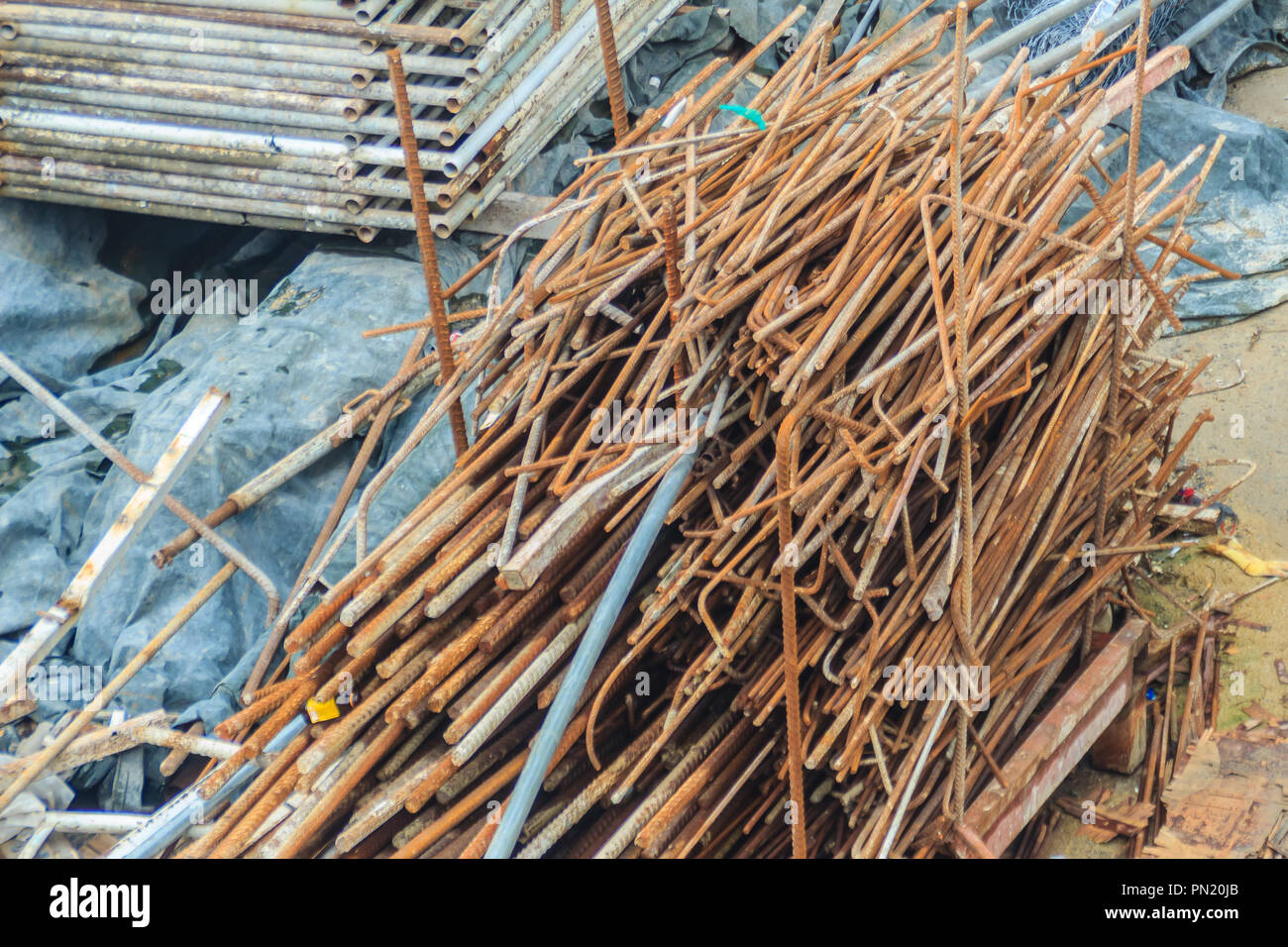Recycled TMT rebar offers a sustainable alternative to traditional steel reinforcement. It’s crafted from repurposed materials, maintaining structural integrity in construction.
Recycled TMT (Thermo-Mechanically Treated) rebar represents an eco-friendly solution in the construction industry, aligning with global efforts to reduce waste and promote sustainability. This type of rebar is produced by recycling discarded steel, conserving natural resources and energy that would otherwise be consumed in the manufacturing of new steel products.
Not only does this recycling process support environmental conservation, but it also ensures that the rebars retain the high strength and ductility required for reinforcing concrete structures. With a growing emphasis on green building practices, the use of recycled TMT rebar is increasingly becoming a preferred choice for contractors and builders who are committed to sustainable development. As the demand for durable and eco-conscious materials rises, recycled TMT rebar stands out as a cost-effective and responsible choice for modern construction projects.
Introduction To Recycled Tmt Rebar
Welcome to our exploration of Recycled TMT Rebar. This innovative material is transforming the construction industry. It’s all about building strong structures while caring for our planet. Let’s dive into the world of Recycled TMT Rebar and discover its importance.
The Rise Of Green Building Materials
The construction world is changing. Green building materials are leading this change. These materials help in saving our environment. They reduce waste and use less energy.
- Less pollution
- Reduced carbon footprint
- Conservation of natural resources
Among these materials, Recycled TMT Rebar stands out. It shows how recycling can make strong, durable buildings.
What Is Tmt Rebar?
TMT Rebar, or Thermo Mechanically Treated Rebar, is a key material in construction. It strengthens concrete structures. This rebar goes through a special process:
- Heating
- Rapid cooling
- Heating again
This process gives it high strength and flexibility. Recycled TMT Rebar uses scrap metal. This makes it an eco-friendly choice.
| Feature | Benefit |
|---|---|
| High strength | Supports heavy structures |
| Flexibility | Resists earthquakes |
| Eco-friendly | Saves natural resources |

Credit: www.amazon.com
Benefits Of Using Recycled Tmt Rebar
Benefits of Using Recycled TMT Rebar are many. Recycled Thermo-Mechanically Treated (TMT) rebar is rising in popularity. It’s an eco-friendly alternative to traditional steel. Builders and engineers choose it for its green credentials and performance.
Environmental Advantages
- Reduces landfill waste: Recycling TMT rebar keeps metal out of landfills.
- Conserves resources: It saves raw materials and energy.
- Lowers emissions: Producing recycled rebar releases fewer greenhouse gases.
Economic Impacts
Recycled TMT rebar is cost-effective. It lowers production and material costs. This savings passes on to customers. It also creates jobs in the recycling sector.
Durability And Strength
Recycled TMT rebar matches new rebar in strength. It withstands high pressure and wear. This makes it suitable for various construction projects. Recycled TMT rebar’s resilience ensures long-term savings in maintenance and repair costs.
The Recycling Process Of Tmt Rebar
Recycling TMT rebar saves resources and energy. The process involves several key steps. Each step ensures the metal is ready for reuse. Let’s explore this eco-friendly journey.
Collection And Sorting Of Scrap Metal
Scrap metal comes from many places. Old buildings, cars, and appliances are common sources. First, workers collect these materials. Then, they sort them by type and quality. Sorting is crucial. It ensures only suitable metals go into TMT rebars.
- Collect metals from demolition sites
- Sort by magnetism and color
- Separate TMT rebar scraps
Melting And Purification
In this step, furnaces heat the scrap metal. High temperatures melt it down. Impurities separate from the metal. This step is vital. It ensures the final product is strong and pure.
- Heat scrap in a furnace
- Remove impurities
- Prepare molten metal for shaping
Manufacturing Of Recycled Rebar
Now, molten metal becomes new TMT rebar. Machines shape it. They cool it down. Then, they cut it to size. The recycled TMT rebar is now ready. It is as strong as new and environmentally friendly.
| Step | Process | Outcome |
|---|---|---|
| 1 | Shape molten metal | New TMT rebar |
| 2 | Cool it down | Strength returns |
| 3 | Cut to size | Ready for use |
Performance Comparison
Let’s explore how Recycled TMT Rebar measures up against new ones. Performance matters in construction. We’ll look at strength, durability, and cost-effectiveness. Here’s the real-world performance of Recycled TMT Rebar.
Recycled Vs. New Tmt Rebar
Recycled TMT Rebar is reprocessed from scrap metal. It offers a green alternative. New TMT Rebar, made from virgin materials, is often seen as more reliable. But is this true? Let’s compare.
- Strength: Recycled rebars match new rebars in tensile strength.
- Flexibility: They bend well, just like new ones.
- Cost: Recycled rebars are often less expensive.
Quality control ensures recycled rebars meet standards. They perform well in various projects. Cost savings make them attractive.
Case Studies
Real projects show the value of Recycled TMT Rebar. Let’s see some examples.
| Project | Type of Rebar Used | Outcome |
|---|---|---|
| Green Building | Recycled TMT | Successful, eco-friendly |
| Infrastructure Upgrade | New TMT | Successful, costlier |
Studies confirm recycled rebars are effective. They support heavy loads and withstand tough conditions. They cut costs and help the planet.
Challenges In Recycling Tmt Rebar
The recycling of TMT rebar presents unique challenges. TMT stands for Thermo-Mechanically Treated. This steel is strong. Recycling it requires careful planning. The process must ensure the integrity of the materials for future use.
Quality Control
Recycled TMT rebar needs quality checks. This ensures the rebars meet building codes. Rebars must retain their strength after recycling.
- Tests confirm the rebar’s durability.
- Chemical analysis checks material composition.
- Physical tests assess flexibility and strength.
Supply Chain Issues
Recycled TMT rebar faces supply chain hurdles. Delivery of recycled material must be timely. Disruptions can cause project delays.
| Issue | Impact |
|---|---|
| Transportation | Delays in delivery |
| Availability | Inconsistent supply |
| Cost | Fluctuating prices |
Certifications And Standards
Understanding Certifications and Standards for Recycled TMT Rebar is crucial. These marks show quality, safety, and trust. Let’s explore the main guidelines and compliance measures.
International Guidelines
Recycled TMT Rebar must meet global standards. These ensure quality across countries. Key organizations set these standards. Examples include ISO and ASTM. They cover everything from strength to durability.
- ISO 9001: Focuses on quality management systems.
- ASTM A615: Specifies the physical properties needed.
- BS 4449: British standard for carbon steel bars.
Compliance And Safety
Safety is top priority for Recycled TMT Rebar. Compliance with regulations ensures this. It means the rebar is safe for buildings and people. Let’s see what compliance involves.
- Material testing: Checks the strength and flexibility of the rebar.
- Environmental impact: Ensures the recycling process is eco-friendly.
- Building codes: Confirms the rebar supports safe construction.
Incorporation In Construction Projects
The construction industry is embracing eco-friendly materials. Recycled TMT rebar is a prime example. This steel reinforcement is made from recycled materials. It offers strength and sustainability. Let’s explore its role in modern construction projects.
Best Practices
Quality assurance is crucial. Builders must confirm recycled TMT rebar meets standards. Proper storage prevents damage. It ensures the rebar remains in top condition.
- Check for certifications: Ensure the rebar has necessary approvals.
- Collaborate with trusted suppliers: This guarantees consistent quality.
- Use correct sizing: Match the rebar size to the project’s needs.
Project Examples
Many projects now use recycled TMT rebar. For instance, Green Building Initiatives prioritize such materials. Here are two examples:
| Project | Location | Use of Recycled TMT Rebar |
|---|---|---|
| Eco-Commercial Plaza | Toronto, Canada | Framing and foundation |
| Sustainable Residential Complex | Stockholm, Sweden | Structural reinforcement |
These examples show recycled TMT rebar in action. They highlight its practicality and benefits. Builders worldwide recognize its value.

Credit: www.alamy.com
Future Of Recycled Tmt Rebar
The Future of Recycled TMT Rebar shines bright as the construction industry evolves. This sustainable material marks a significant shift towards eco-friendly building practices. With advancements in recycling technology and market trends indicating a positive upswing, Recycled TMT Rebar stands at the forefront of innovation and economic growth.
Innovations In Recycling Technology
Recent breakthroughs have revolutionized the recycling of TMT Rebar. Cutting-edge processes now allow for enhanced material recovery. This results in higher quality Recycled TMT Rebar. Industry leaders invest heavily in R&D to push these innovations further. Smart factories employ AI to optimize recycling efficiency. These developments ensure a consistent supply of this eco-friendly resource.
Market Trends And Predictions
- Demand for green materials rises as awareness grows.
- Construction sector adopts sustainable practices.
- Recycled TMT Rebar market is set to expand significantly.
- Regulations encourage use of recycled materials.
- Experts predict a robust growth trajectory.
Analyses indicate a promising future for Recycled TMT Rebar. Economic incentives and environmental benefits drive this trend. The material’s versatility and strength appeal to engineers and architects alike. As the world leans into sustainability, Recycled TMT Rebar becomes a key player in the industry.
Frequently Asked Questions
What Is The Difference Between Rebar And Tmt Bar?
Rebar, or reinforcing bar, is made of carbon steel and has ridges for better concrete adherence. TMT bars, or Thermo-Mechanically Treated bars, undergo a special process for higher strength and flexibility.
Is Rebar Made From Recycled Steel?
Yes, manufacturers often make rebar from recycled steel. This process is environmentally friendly and ensures the efficient use of resources. Recycled steel retains its strength, making rebar a durable choice for construction.
What Is Tmt In Steel Bar?
TMT in steel bar stands for Thermo Mechanically Treated, which refers to a strengthening process for enhancing the bar’s durability and flexibility.
What Is The Alternative To Tmt Bar?
An alternative to TMT bars is Structural Steel Rebars, known for their high strength and flexibility in construction projects.
Conclusion
Embracing recycled TMT rebar is a step forward in sustainable construction. This choice not only supports environmental health but also offers cost efficiency and durability. By opting for recycled materials, the construction industry can significantly reduce its carbon footprint. Let’s prioritize green building practices to ensure a healthier planet for future generations.





















